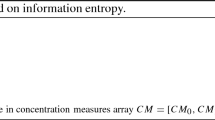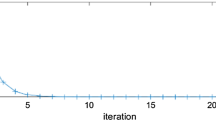Abstract
Here, we analyze sparse analysis windows for complex-valued and real-valued discrete Gabor transforms. A number of theories presented in this study indicate that the existence and uniqueness of a sparse analysis window for a given synthesis window depend to a great extent on the sparsity of the synthesis window. Specifically, the upper and lower bounds on the analysis window sparsity are obtained for synthesis windows of different sparsities and analyzed in detail. Particularly, if the sparsity of a given synthesis window with connected support is equal to the discrete Gabor transform time-shift parameter, the sparsest analysis window is unique. In addition, we propose an algorithm that searches for a sparse analysis window. Compared with existing algorithms, a sparse analysis window with fewer nonzero elements and/or smaller reconstruction errors can be obtained with the proposed algorithm. A sequence of experimental results reveals its superior effectiveness. In addition, a better Gabor representation with high concentration and time–frequency resolution is obtained with the sparse analysis window.










Similar content being viewed by others
References
L. Bianco, D. Gottas, J.M. Wilczak, Implementation of a Gabor transform data quality-control algorithm for UHF wind profiling radars. J. Atmos. Ocean. Technol. 30(12), 2697–2703 (2013)
R.M. Bracewell, The fast hartley transform. Proc. IEEE 72(8), 1010–1018 (1984)
P.G. Casazza, A. Heinecke, F. Krahmer, G. Kutyniok, Optimally sparse frames. IEEE Trans. Inf. Theory 57(11), 7279–7287 (2011)
O. Christensen, Pairs of dual Gabor frame generators with compact support and desired frequency localization. Appl. Comput. Harmon. Anal. 20, 403–410 (2006)
O. Christensen, H.O. Kim, R.Y. Kim, Gabor windows supported on [\(-\)1, 1] and dual windows with small support. Adv. Comput. Math. 36, 525–545 (2012)
O. Christensen, Y.C. Eldar, Generalized shift-invariant frames and duals for subspaces. J. Fourier Anal. Appl. 11, 299–313 (2005)
O. Christensen, Y.C. Eldar, Oblique dual frames and shift-invariant spaces. Appl. Comput. Harmon. Anal. 17(1), 48–68 (2004)
I. Daubechies, H.J. Landau, Z. Landau, Gabor time–frequency lattices and the Wexler–Raz Identity. J. Fourier Anal. Appl. 1(4), 437–478 (1995)
H.G. Feichtinger, T. Strohmer, Gabor Analysis and Algorithms-Theory and Applications (Birkhäuser, Boston, 1998)
P. Flandrin, P. Borgnat, Time–frequency energy distributions meet compressed sensing. IEEE Trans. Signal Process. 58(6), 2974–2982 (2010)
D. Gabor, Theory of communication. J. Inst. Electr. Eng. 93(3), 429–457 (1946)
K. Gröchenig, Foundations of Time–Frequency Analysis (Birkhäuser, Boston, 2001)
M. Hampejs, G. Kracher, The inversion of Gabor-type matrices. Signal Process. 87(7), 1670–1676 (2007)
A. Joseph, A.K. Brodzik, R. Tolimieri, Under-sampled Weyl–Heisenberg expansions via orthogonal projections in Zak space. Signal Process. 81(11), 2383–2402 (2001)
F. Krahmer, G. Kutyniok, J. Lemvig, Sparsity and spectral properties of dual frames. Linear Algebra Appl. 439, 982–998 (2013)
G. Kutyniok, W.Q. Lim, Compactly supported shearlets are optimally sparse. J. Approx. Theory 163, 1564–1589 (2011)
S. Li, Y. Liu, T. Mi, Sparse dual frames and dual Gabor frames of minimal time and frequency supports. J. Fourier Anal. Appl. 19(1), 48–76 (2013)
S. Li, H. Ogawa, Pseudo frames for subspaces with applications. J. Fourier Anal. Appl. 10(4), 409–431 (2004)
Z. Liu, X. Wei, X. Li, Aliasing-free micro-doppler analysis based on short-time compressed sensing. IET Signal Process. 8(2), 176–187 (2013)
Z. Liu, P. You, X. Wei, D. Liao, X. Li, High resolution time–frequency distribution based on short-time sparse representation. Circuits Syst. Signal Process. 33(12), 3949–3965 (2014)
M. Matthe, L.L. Mendes, G. Fettweis, Generalized frequency division multiplexing in a Gabor transform setting. IEEE Commun. Lett. 18(8), 1379–1382 (2014)
S. Moreno-Picot, M. Arevalillo-Herraez, W. Diaz-Villanueva, A linear cost algorithm to compute the discrete gabor transform. IEEE Trans. Signal Process. 58(5), 2667–2674 (2010)
S. Qian, D. Chen, Discrete Gabor transform. IEEE Trans. Signal Process. 41(7), 2429–2438 (1993)
S. Qiu, Gabor-type matrix algebra and fast computations of dual and tight Gabor wavelets. Opt. Eng. 36(1), 276–282 (1997)
H. Rabbani, S. Gazor, Local probability distribution of natural signals in sparse domains, in IEEE International Conference on Acoustics, Speech and Signal Processing, May 22–27 (2011)
N. Saini, A. Sinha, Face and palmprint multimodal biometric systems us ing Gabor–Wigner transform as feature extraction. Pattern Anal. Appl. 18(4), 921–932 (2015)
I. Shafi, J. Ahmad, S.I. Shah, F.M. Kashif, Quantitative evaluation of concentrated time–frequency distributions, in 17th European Signal Processing Conference, Glasgow, pp. 1176–1180 (2009)
T. Strohmer, Numerical algorithms for discrete Gabor expansions, in Gabor Analysis and Algorithms: Theory and Applications, ed. by H.G. Feichtinger, T. Strohmer (Birkhäuser, Boston, 1998)
L. Tao, H.K. Kwan, 1-D and 2-D real-valued discrete Gabor transforms, in 43rd IEEE Midwest Symposium on Circuits and Systems, August 8–11 (2000)
L. Tao, G. Hu, H.K. Kwan, Multiwindow real-valued discrete Gabor transform and its fast algorithms. IEEE Trans. Signal Process. 63(20), 5513–5524 (2015)
L. Tao, H.K. Kwan, Novel DCT-based real-valued discrete Gabor transform and its fast algorithms. IEEE Trans. Signal Process. 57(6), 2151–2164 (2009)
L. Tao, H.K. Kwan, Multirate-based fast parallel algorithms for DCT-kernel-based real-valued discrete Gabor transform. Signal Process. 92(3), 679–684 (2012)
M. Temerinac, Discrete Fourier-invariant signals: design and application. IEEE Trans. Signal Process. 60(3), 1108–1120 (2012)
T. Werther, E. Matusiak, Y. Eldar, N. Subbanna, A unified approach to dual Gabor windows. IEEE Trans. Signal Process. 55(5), 1758–1768 (2007)
J. Wexler, S. Raz, Discrete Gabor expansions. Signal Process. 21(3), 207–220 (1990)
N. Yahya Bey, Multi-resolution Fourier analysis: time–frequency resolution in excess of Gabor–Heisenberg limit. Signal Image Video Process. 8(4), 765–778 (2014)
Acknowledgements
This work was supported in part by the National Natural Science Foundation of China under Grant Nos. 61301295 and 61372137, the Natural Science Foundation of Anhui Province under Grant No. 1708085MF151 and the Doctoral Fund of Anhui University. The authors would like to thank the anonymous reviewers for valuable input.
Author information
Authors and Affiliations
Corresponding author
Rights and permissions
About this article
Cite this article
Zhou, J., Fang, X. & Tao, L. A Sparse Analysis Window for Discrete Gabor Transform. Circuits Syst Signal Process 36, 4161–4180 (2017). https://doi.org/10.1007/s00034-017-0510-0
Received:
Revised:
Accepted:
Published:
Issue Date:
DOI: https://doi.org/10.1007/s00034-017-0510-0




